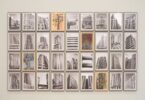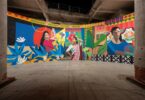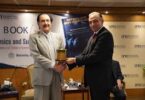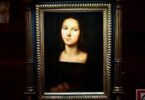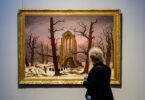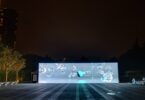Monitoring Desk
AMSTERDAM: It all started with a yellow cow and a leap of faith.
In 2008, Aarnout Helb, a young Dutch lawyer who studied at Leiden University, was reading the Holy Qur’an while trying to piece together a larger global narrative from a legal and artistic perspective.
While poring over the various passages in the holy book, he came across the story of the yellow cow from Surat Al-Baqarah.
It ignited something within him. After a quick internet search, a piece of art by a Saudi artist popped up — about that very same yellow cow mentioned in the Qur’an. He couldn’t believe his luck. He sent a message to the artist right away.
The artist wrote back. And that was how Helb serendipitously started his long relationship with Saudi artists which resulted in him creating the Greenbox Museum of Contemporary Art from Saudi Arabia in Holland.
The artist who made the Yellow Cow piece was none other than world-renowned Saudi artist Dr. Ahmed Mater, who has since become his friend. Today, the book by Mater — with the yellow cow on the cover — sits proudly on the main table upon entering the museum space. Pieces from the yellow cow project have been acquired by Helb — and then some.
Helb is an unlikely connector to Saudi Arabia’s art scene. Today, at 58 years old, he’s a bit of an introvert, mostly working alone around his space, which he likes to refer to as his “cabinet of curiosities.”
He started to piece together the collection based on what captivated his imagination and fascinated his sensibilities.
After the constant misrepresentation in the news following the tragic events of 9/11, where several of the hijackers were Saudi-born, Helb kept that fascination tucked away until 2008 when he started to really see a shift in the world.
He refers to that time as a global “mental prison,” where Islam and the West seemingly couldn’t cooperate and he wanted to try and get to the bottom of things.
“I started this in a very complex way — it’s always difficult to explain, but it was influenced very much by 9/11. And the period after that, because I didn’t start right away. I started in 2008, which is much, much later but the world was in some kind of mental prison after that.
“You know, these ideas that Islam and the West — or whatever you call it — can’t work together. And to my mind, it made no sense for Holland within the NATO structure as friends of the US to try and reorganize Afghanistan into our vision of how a country should work,” he told Arab News.
“My knowledge about Saudi Arabia prior to this museum was very much influenced by the fact that I have Indonesian roots, and Indonesia is one of the largest Islamic countries in terms of population. And there has always been a very strong relationship between Holland from its Indonesian colonizing context — specifically the Hijaz region because of Makkah and Madinah — so we’ve been involved with making money and taking care of pilgrims at the same time,” he said.
“Saudi Arabia culturally is extremely important for the world — not because you have oil in Dhahran, not because in Riyadh you have a nice royal family; it’s important because people from all over the world travel to Makkah and Madinah,” Helb said.
His first visit to Saudi Arabia was in 2013 after many years of surrounding himself with the Kingdom’s art.
The reason the trip was delayed was because he was, and is, adamant at remaining independent. Every single piece in the collection was curated carefully and thoughtfully by him and not influenced by anyone else.
It’s hard to gauge how many pieces he has in the collection, because some are part of a series, but he estimates that he has over 100 works.
“Although the museum started in dead center Amsterdam, at some point, the space was not big enough for me. It was a rented space and I went looking to buy something within the budget I have, and this is a small warehouse, where the collection — which is not my private collection, I finance it privately — but it’s a public space for people to visit.
“It has statutes about what it should do. And the art, although owned by me, is bought with the statutes in mind. And it’s given into use to the foundation for public viewing and research. I take that seriously.”
According to Helb, three types of visitors typically came through the doors.
“The Dutch visitors come because I’m here; the international visitors who somehow find me and usually have some interest in the Middle East — they don’t come completely out of the blue — which happened more when I was still in the center because that was easy to come; and Saudis actually visiting … those I find most interesting because I learn about the art from them,” he said.
He has been to the kingdom several times since but his home base is in Holland.
Last year, Helb moved his museum to a remote location in Hoofddorp, where he took his own time unwrapping each piece and putting it in its new place — something he realized was a blessing.
Helb is still deciding on the exact shade he wants to paint the museum and isn’t sure if he wants to replicate the old wall’s tint, deliberating over the exact green hue that might grace the walls of the new Greenbox.
Ironically, and perhaps fittingly, the color green in the museum’s name was not chosen as a patriotic nod to the Saudi flag but rather due to a personal connection to Helb, who admired a painting in his home with a green tone which relaxed him.
The new location brought in a slew of unexpected visitors: Taxi drivers with origins in North Africa, many of whom reside on the outskirts of Amsterdam because it is more affordable.
Those Dutch nationals with strong pride in their Arab or Muslim roots usually don’t bike or use local public transport, so they come with their cars, park and just wander in.
The space is just a 15-minute drive from Schiphol Airport in Amsterdam, which is a five-hour flight from the closest Saudi city.

